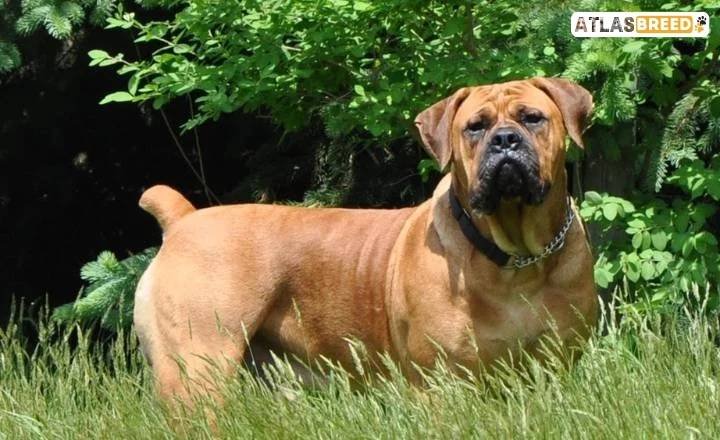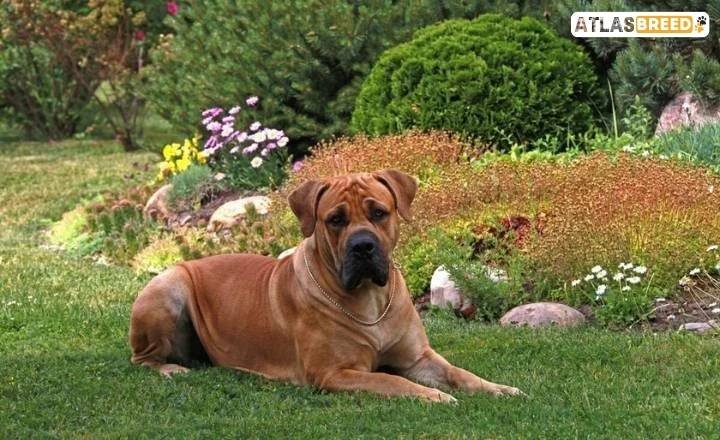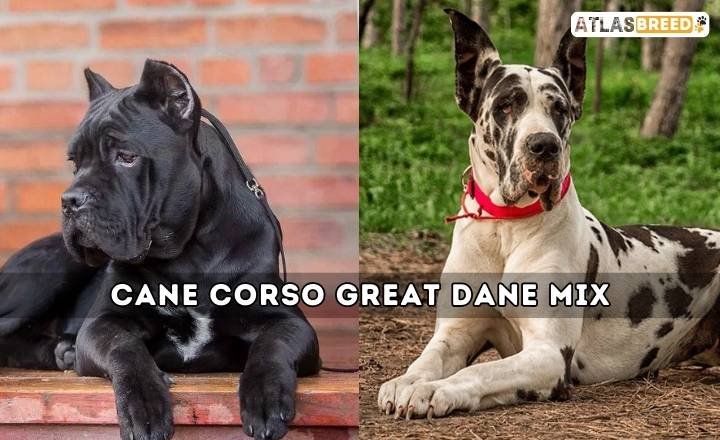The Boerboel is a strong and powerful dog breed that hails from South Africa, where it was originally developed for the purpose of safeguarding farms and defending livestock against threats. Renowned for their physical strength, loyalty, and smarts, Boerboels need consistent care and focus during their developmental phases to thrive as healthy adults.
In the first 18 to 24 months of life, these dogs undergo significant growth in height, muscle development, and overall strength. Balancing their diet and exercise is essential to prevent excessive growth or potential joint problems.
Boerboel Growth Chart
The Boerboel is a large and powerful breed known for its loyalty, strength, and protective nature. Like any dog, understanding its growth phases can help you ensure its health and well-being. This article will break down Boerboel’s growth stages, factors affecting its development, and tips to help your dog grow optimally.
| Age | Weight | Height |
| 1 month | 5 – 20 lbs | 8 – 10 inches |
| 2 months | 15 – 30 lbs | 10 – 12 inches |
| 3 months | 30 – 45 lbs | 12 – 14 inches |
| 4 months | 45 – 60 lbs | 14 – 16 inches |
| 5 months | 65 – 80 lbs | 16 – 18 inches |
| 6 months | 80 – 100 lbs | 18 – 20 inches |
| 7 months | 90 – 115 lbs | 20 – 22 inches |
| 8 months | 95 – 130 lbs | 22 – 24 inches |
| 9 months | 100 – 140 lbs | 22 – 25 inches |
| 10 months | 110 – 150 lbs | 23 – 25 inches |
| 11 months | 120 – 165 lbs | 23 – 25 inches |
| 12 months | 125 – 175 lbs | 23 – 26 inches |
| 24 months | 150 – 200 lbs | 23 – 27 inches |
Boerboel Growth Stages
Boerboels go through several stages of growth, each with its challenges and milestones.
Neonatal Stage (0-2 Weeks)

During this period, puppies are entirely dependent on their mother. Their eyes and ears remain closed, and they rely on touch and scent to move around. Their main activity is feeding and sleeping.
Transitional Stage (2-4 Weeks)
By two weeks, Boerboel puppies start opening their eyes, standing, and interacting more with their environment. Fundamental motor skills and social interaction with littermates develop during this period.
Socialization Stage (4-12 Weeks)
Between 4 and 12 weeks, Boerboel puppies undergo rapid development. They begin interacting with humans and other animals, making this the perfect time for early socialization and gentle training. They also start learning from their environment.
Juvenile Stage (3-6 Months)

The juvenile stage marks rapid physical growth. Puppies will develop their muscles, and you’ll notice their playful and curious nature. They require proper nutrition and exercise to support healthy growth at this stage.
Adolescent Stage (6-18 Months)
By the time they reach six months, Boerboels experience a growth spurt. Their bodies start to fill out, and they develop more muscle mass. Mental and emotional maturity is still a work in progress during this stage, so consistency in training is essential.
Adult Stage (18-24 Months)
At around 18 months, Boerboels mature into their full adult size. Although growth slows down, they continue to develop muscle tone and bulk.
At What Age Is A Boerboel Fully Grown?
A Boerboel is typically fully grown by 2 to 3 years old. While most of the growth in height and length occurs within the first year, muscle development and full physical maturity may take up to three years. Males tend to be larger and bulkier than females, often weighing 150-200 lbs, while females usually range from 110-140 lbs.
Factors That Affect Boerboel’s Growth Rate
Various factors can influence how fast and large a Boerboel grows, including:
Genetics: A dog’s lineage plays a significant role in determining its final size. If the parents are large, the puppies are likely to be too.
Nutrition: A balanced diet rich in protein and essential nutrients is critical during a Boerboel’s growth phase. Avoid overfeeding, as rapid weight gain can lead to joint and bone problems.

Exercise: Regular exercise supports healthy bone and muscle development. Young Boerboels should avoid overly strenuous activity to prevent injuries to growing joints.
Health Issues: Certain health conditions, such as hormonal imbalances or parasitic infections, can affect your dog’s growth rate. Regular veterinary check-ups are essential to catch any issues early.
Spaying/Neutering: Early spaying or neutering can impact growth patterns. Some studies suggest that delaying these procedures until the dog has finished growing can lead to more even development.
What If Your Boerboel Is Too Big?
Boerboels are naturally large dogs, but it’s essential to differentiate between a healthy, muscular build and obesity. Excessive weight can lead to serious health issues and shorten your Boerboel’s lifespan.
Common Problems of Obesity in Boerboels:
- Diabetes: Obesity increases the risk of insulin resistance, which can lead to diabetes. Managing your dog’s weight is crucial in preventing this chronic condition.
- Heart Conditions: Extra weight strains the heart, increasing the risk of high blood pressure, heart disease, and even heart failure.
- Joint Problems: Being overweight stresses joints, leading to arthritis, hip dysplasia, and other mobility issues. Giant breeds like Boerboels are especially prone to joint problems as they age.
- Skin Conditions: Folds of excess fat can cause irritation, infections, and other skin problems, making your dog uncomfortable.
- Kidney Disease: Obesity can negatively affect kidney function, potentially leading to chronic kidney disease.
- Lack of Mobility: Overweight dogs may find it challenging to move around, leading to a sedentary lifestyle that exacerbates weight gain and muscle deterioration.
- Cancer: Research shows a connection between obesity and a higher risk of certain dog cancers.
- Decreased Quality of Life: Obese dogs often have less energy, tire quickly, and experience discomfort, which affects their happiness.
- Shortened Lifespan: Studies have shown that dogs at a healthy weight live longer than overweight ones, highlighting the importance of weight management.
Signs of Obesity in Boerboels:
It’s essential to recognize the signs of obesity early to prevent further health complications. Some common signs include:
You cannot feel your dog’s spine and ribs: If it’s hard to feel your Boerboel’s ribs or spine under a layer of fat, it clearly indicates that your dog may be overweight.
His waistline has become too big: From above, your dog should have a noticeable waistline. If the waist isn’t visible or the abdomen looks rounded, it indicates excessive weight.

Your Boerboel is refusing to go on walks: Reluctance to exercise or walk could mean your dog carries too much weight, making movement uncomfortable or tiring.
Excessive panting: If your Boerboel pants heavily even after light exercise or at rest, it could indicate they are struggling with weight.
Difficulty with stairs or getting in and out of the car: An overweight dog may need help going up or down stairs, getting into a car seat, or even standing up after lying down.
Tips To Help Your Boerboel Grow
Balanced Diet: Feed a high-quality dog food formulated for large breeds. It should contain appropriate protein, fat, and calcium to support growth.
Regular Exercise: Boerboels need consistent, moderate exercise to build muscle and maintain a healthy weight. Puppies, on the other hand, should avoid high-impact activities as their joints are still developing.
Mental Stimulation: Mental stimulation is essential in addition to physical exercise. Engage your Boerboel in puzzle games and interactive toys to develop cognitive abilities. Scheduled Vet Visits: Routine check-ups are crucial to ensure your Boerboel grows correctly and addresses any health issues early.
Training: Proper training and socialization from a young age will help your Boerboel grow into a well-behaved adult. This breed is intelligent but can be stubborn, so consistent, positive reinforcement is critical.
Does Size Matter?
While Boerboels are a large breed, size alone should not define their health or well-being. What truly matters is the dog’s overall condition, strength, and temperament. Focus on maintaining your Boerboel at a healthy weight and fitness level rather than aiming for a specific size. A well-cared-for Boerboel is likelier to live a long, happy, and active life.
Conclusion
The growth of a Boerboel is a journey that takes around two to three years. By understanding the different stages of growth and the factors that influence development, you can help your Boerboel thrive.
Whether through proper nutrition, regular exercise, or timely vet visits, ensuring your dog’s health should always be a priority. Size isn’t everything what matters most is raising a happy, healthy Boerboel.
FAQ’s
How big should a 6-month-old Boerboel be?
A 6-month-old Boerboel typically weighs between 70-90 lbs, depending on genetics, diet, and activity level.
When do Boerboels stop growing?
Boerboels generally stop growing in height by 18-24 months but may continue developing muscle mass until around 3 years of age.
Can a Boerboel’s size be stunted?
Yes, poor nutrition, lack of exercise, or health issues can stunt a Boerboel’s growth. Ensuring proper care from a young age is key to healthy development.






